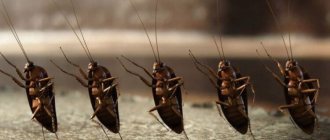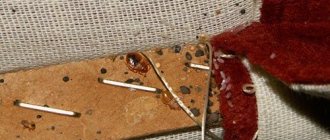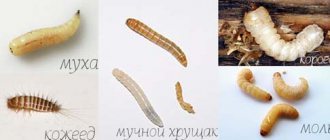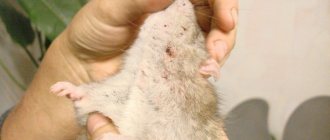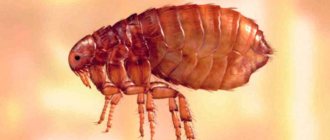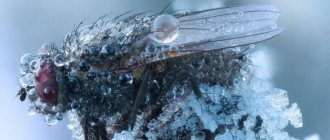Small black fleas that jump on the floor in a house or apartment and painfully bite pets and people are a cause for concern. In addition to painful bites and irritating itching, black fleas are dangerous because they carry infectious diseases. Let's look at what black fleas look like, what is known about these parasites, where they come from, and how to remove black fleas from your home.
What kind of fleas are there?
Scientists were able to identify, classify and describe more than 2 thousand species of fleas . But we are only interested in three of them:
- Dog fleas (Ctenocephalides canis).
- Felids (Ctenocephalides felis).
- Rat fleas (Xenopsylla cheopis).
It is worth briefly describing each of these types, how they differ from each other, and how dangerous they are to humans.
Dog fleas
Photo of fleas on a dog
Dog flea bites are painful and cause characteristic itching and redness. Can carry dangerous bacteria and infections. Fleas get into the house on the fur of pets after another walk. A dog can become infected either from other animals or after going to an infected place. Fleas, without a constant host (food source), live well in the ground, sand or in the nests of birds and rodents.
Dog fleas live and breed in fur, which makes sense. Externally, dog fleas are similar to cat fleas, but they still differ from each other.
Interesting fact! A flea colony consists of adult ectoparasites, larvae, eggs and pupae. At the same time, adult fleas make up only a small part of the colony - no more than 5-7% . This is important to know before you start fighting fleas.
Cat fleas
Fleas on a cat
Fleas on a cat look (if you can see them) not much different from those on a dog. And they behave similarly. They settle in cat fur after another walk or meeting an infected animal.
Cat fleas bite humans with pleasure. Even if there is a constant source of food nearby or several (cats, dogs), a flea can bite a person. At the same time, flea bites are rarely located above the knees - where they jump, they bite.
A cat flea bite is painful and dangerous. It can cause infection with brucellosis or rickettsiosis. If you do not fight fleas, the colony quickly grows to obscene sizes, affecting the life of the residents of the house.
Rat fleas
Rat fleas pose the greatest danger to humans. This is because rats themselves are carriers of dangerous diseases, for example: tularemia, brucellosis or plague.
You can read more about rats in this article.
At the same time, fleas do not live on rats, more often in their nests, constantly feeding on their blood . Rat fleas bite quickly and painfully. Flea bites are especially dangerous for children.
Symptoms and characteristic signs
Cat fleas leave the faintest marks on the human body. After an hour, the affected area is no longer itchy, and the redness goes away within 2-3 days. Typical symptoms and signs of a bloodsucking bite are as follows:
- When the skin is bitten, the man experiences acute pain, which feels similar to an injection from a medical syringe.
- A noticeable itching appears, stronger than after a mosquito bite.
- As a rule, insects bite a person up to the knee, but if fleas attack while sleeping, they can reach the armpits.
- Characterized by a series of punctures on the skin, the insect bites in several places at once with a distance of 1-2 cm from each other.
Can humans have fleas?
Photo of a flea under a microscope
Nature is so generous that it has provided a separate type of flea for humans. It's called Pulex irritans . This species can live on a person for some time, but only in the case of a complete lack of hygiene of the latter. And human fleas are extremely rare. They reproduce in other places, only coming to Homo Sapiens to eat.
But dog, cat and rat fleas are very common. And they, without a twinge of conscience, bite a person, a small child, and even your parrot. These parasites are extremely gluttonous and indiscriminate in their taste preferences.
They bite painfully because they do not inject any substances during the bite, like mosquitoes or ticks, for example. And fleas don’t hide, but brazenly climb wherever they need to and dig their jaws into the skin. This is what a flea looks like at 20x magnification.
Therefore, the answer to the question: “ Can fleas live on humans ?” - no, they can’t, but they drink his blood with pleasure, leaving itchy and painful wounds and, possibly, a couple of pathogens of dangerous diseases.
Treatment methods:
- Use cold compresses. This will help eliminate itching, relieve swelling and relieve pain. Wash the affected areas with soapy, warm water, then apply ice.
- Baking soda relieves inflammation, reduces itching and reduces the risk of infection. The recipe is simple - mix a teaspoon of baking soda with water, then spread on the affected area. Leave the paste for 7-10 minutes, then rinse with water. You can use this method for pets as well. Dissolve a glass of baking soda in water and rinse your pet; the procedure will make your pet’s life much easier.
- Apple cider vinegar will prevent infection and relieve itching. Make compresses for several minutes, applying them to the bite site. In addition, you can spray vinegar diluted with water in areas where parasites are most concentrated.
- Aloe vera extract is an excellent antiseptic that will help relieve inflammation and itching and speed up healing. It is necessary to lubricate the wound with juice from aloe leaves. Leave the product on for 10-15 minutes, then rinse it off with warm water.
- “Oatmeal, sir!”, yes, don’t be surprised, so does she! Powdered oatmeal paralyzes toxins in the skin and soothes inflammation. Recipe: Prepare a thick mixture of equal parts finely ground oatmeal and yogurt, plus a small amount of honey. Apply the balm to the affected areas of the skin and leave for half an hour, then rinse with water.
The first signs of fleas in the house
Fleas bit the child
Fleas can get into your house not only through our little brothers, you can bring them yourself. These parasites often live in dark and damp places. For example, a basement or barn.
The only condition for the survival of the colony is regular nutrition . And this is usually no problem, since mice, rats, and sometimes cats and dogs live well in the same places. Therefore, fleas can be brought into the house with some item, for example, with an old carpet from a long-forgotten basement.
How to understand that you have fleas in your apartment . There are several obvious and not so obvious signs:
- The main sign of fleas appearing in your home is bites, and not just single ones. When the flea gets to the victim, it can bite 10-30 times.
- Mostly fleas bite on the legs, but if your pets sleep in bed with you, and the colony of parasites has grown to impressive sizes, flea bites will be on the back, on the arms, and even on the face.
- The second obvious sign of the appearance of fleas in your home is that the cat or dog begins to scratch itself frequently and diligently.
- You may also occasionally see fleas. Of course, this is extremely difficult to do because of their size, but with a large number of parasites in the house, sometimes you can notice their movement.
Fleas on a summer cottage
Intensively treat areas where your pet often spends time: a house, under the porch, a barn room where a dog or cat is. Adult fleas willingly live in dark, humid places .
The ideal environment for them is one where there is decomposed organic food debris. Fleas also often jump to open areas of the lawn, where animals regularly visit. Properly dispose of organic debris: fallen leaves in the fall, used for bedding, straw removed from the grass area. Such debris can be buried under trees, fertilizing them and protecting the roots from freezing in the harsh winter. And fleas will be deprived of a comfortable habitat.
This is also interesting: Flea bites on humans: how to identify and how to get rid
You can also use outdated disinfectants on the site: chlorophos, dichlorvos and karbofos.
How can you become infected after a flea bite?
Let us immediately make a reservation that the transmission of pathogenic bacteria does not occur with every flea bite. According to statistics, approximately every hundredth to two hundredth bite can be infectious and potentially dangerous . Much depends on the conditions in which you live, in which city, country.
But one thing is known for sure - the more and more often fleas bite you, the higher the likelihood that some helminths will still settle in your body, whether you want it or not . Next, we’ll tell you where and what you can get infected with.
Plague
We have already partially mentioned this terrible disease, so we will not focus on it. Let us just add that the pain is not pleasant. The incubation period lasts from 5 to 8 days.
Interesting fact! In all three global plague epidemics (in the 6th, 14th and 19th centuries), the carriers of the Yersinia pestis plague bacilli were fleas that bit infected rats.
Fleas bit my leg (photo)
There are three types of plague:
- bubonic – it is the most common and best treatable;
- pneumonic plague - characterized by extensive damage to the lungs, pneumonia (extremely contagious and is a moderate form in severity);
- septicemic is the most difficult form for both the patient and doctors, since it is difficult to treat and often leads to death.
Let us remind you once again that in our time the plague is extremely rare, and, as a rule, in remote regions and countries. There is no need to be afraid of it, but it doesn’t hurt to be informed.
Hymenolepiasis
Hymenolepiasis is a worm that lives in the large intestine. In every second case, the disease is asymptomatic. Moreover, parasites can live in the body for quite a long time until they are identified (stool analysis) and destroyed by one of the modern antibiotics.
What symptoms may appear:
- heartburn;
- nausea;
- skin rash;
- diarrhea;
- dizziness;
- lack of appetite;
- severe periodic abdominal pain;
- Quincke's edema is possible.
It is treated relatively easily and without consequences.
Typhus
The causative agents of typhus are also transmitted from infected animals to humans through the bite of a flea. The disease is accompanied by symptoms such as:
- increased body temperature;
- feverish condition;
- hence the confusion, delirium;
- typhus can severely damage the central nervous system (CNS);
- affect the normal functioning of the cardiovascular system.
The disease is quite dangerous, but if you diagnose it in time and start timely treatment, then everything will be fine.
Tularemia
Tularemia is a dangerous zoonotic infection transmitted from animals to humans. The route of transmission is the same fleas , but not only them.
If the disease is allowed to develop, the kidneys, lungs and intestines are likely to be affected. The eyes may also be affected. Suppurations will begin to appear on the body. Severe inflammation of the lymph nodes is often observed .
The symptoms of the disease at the beginning of its development are very similar to a common acute respiratory infection: headache, fever, body aches, etc. Should you see a doctor? Undoubtedly! This could save your life.
Let us remind you! The advice to go to the hospital is not an empty call! Any infectious or bacterial disease requires medication, often inpatient treatment. Don't ignore modern medicine.
Helminths
Very unpleasant and very dangerous parasites. They happily settle in the large intestine, beginning to actively reproduce. The symptoms are similar to hymenolipedosis, we will not repeat it.
Helminths can harm the body by reducing immunity. If they are not detected in time, and if concomitant diseases that arise against the background of reduced immunity are treated independently, the story can end very badly.
These are not all diseases transmitted through flea bites. There are more of them, much more. But all of them are either extremely rare or located in subequatorial countries. For example, many subspecies of intestinal parasites live in Africa, India, and parts of Asia. We don't have those.
Folk remedies
It is not always possible to kill fleas with modern insecticides. In such cases, there is hope for the help of folk recipes.
The most popular means:
- turpentine with soap solution;
- infusion of cedar leaves;
- a mixture of brewer's yeast and garlic;
- salt;
- infusion of mint and eucalyptus leaves;
- soda;
- infusion of tansy and wormwood;
- citrus fruit peel;
- kerosene;
- pine sawdust;
- Persian chamomile;
- garlic.
Fleas cannot stand strong odors and try to get out of the room as quickly as possible. Procedures using folk remedies are carried out regularly, otherwise the pests will return to the ventilated house.
Mixtures and infusions are added at a 1:1 ratio and taken into account so that there is enough to treat all surfaces in the house. The infusions must be poured with boiling water and infused for 24 hours. They are then added to the water for cleaning floors.
Citrus peels do not need to be processed. It needs to be spread out in all rooms - the smell will irritate fleas and drive them away from their homes.
Pine sawdust and fresh Persian chamomile are placed around the perimeter of the room and in the corners. Fleas most often hide under the floor, baseboards or in small cracks near the walls. If these ingredients are left at the front door, then fleas, hiding on an animal or person while still on the street, will try to immediately escape from the unpleasant house.
Pets suffer from pungent herbal odors, so during treatment they should be removed from the house for 2-3 hours or treated rooms in turn, transferring the animal from one room to another.
Kerosene is considered one of the best remedies. Half a glass of the product is added to a bucket of water and the resulting solution is used to wash the floor. Then the room is ventilated. Fleas often die after the first use of kerosene.
How to get rid of fleas in an apartment
The question of how to get rid of fleas in an apartment usually arises when the situation is advanced. We strongly advise against acting on your own . And the point is not that a person cannot cope with fleas. There are modern aerosols and sprays against fleas. The point is different: professional pest control will kill all parasites, including those living under the baseboards, under the carpet, in mouse holes or in small cracks.
Therefore, if you have the opportunity to pay for the services of the sanitary and epidemiological service, do it ! We do not advertise any company, we simply recommend the most effective option.
Danger of bites
Fleas themselves can cause two diseases in humans: sarcopsillosis and pulicosis. But parasitic insects also carry infections, including even hepatitis B and C. By feeding on an infected organism, they can transmit the infection to the next victim and even turn it into a carrier. This is the main danger of parasites; there is a risk of getting bacteria and viruses into the body as a result of their bites. Therefore, you should not assume that, for example, cat fleas do little harm.


